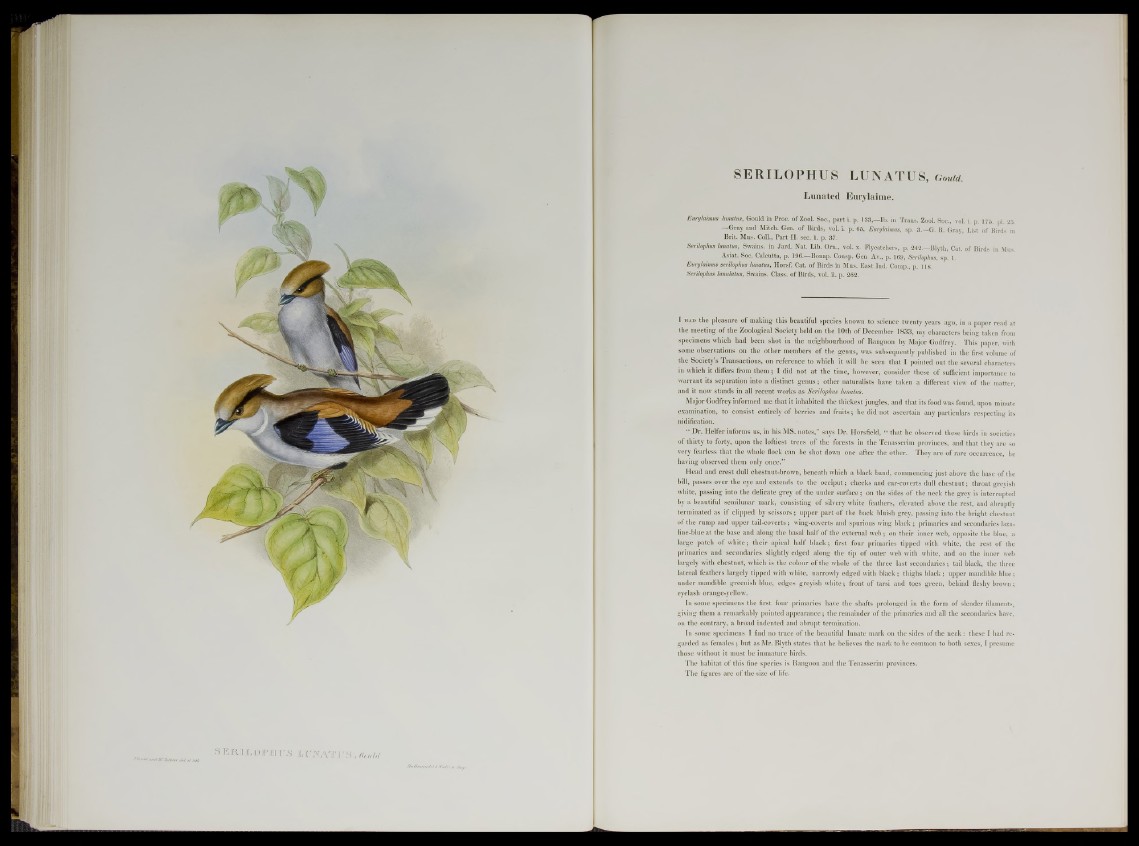
SERILOPHUS LUNATUS, Gould.
L u n ated Eurylaime.
Eurylaimm hmatus, Gould in Proc. of Zool. Soc., p art i. p. 133,—lb. in Trans. Zool. Soc., vol. i. p. 175. pi. 25.
—Gray and Mitch. Gen. of Birds, vol. i. p. 65, Eurylaimm, sp. 3.—G. R. Gray, List of Birds in
Brit. Mus. Coll., Part II. sec. 1 . p. 37.
Serilophus lunatus, Swains, in Jard. Nat. Lib. Om., vol. x. Flycatchers, p. 242.—Blyth, Cat. of Birds in Mus.
Asiat. Soc. Calcutta, p. 196.—Bonap. Consp. Gen. Av., p. 169, Serilophus, sp. 1 .
Eurylaimus serilophus lunatus, Horsf. Cat. of Birds in Mus. East Ind. Comp., p. 118.
Serilophus lunulatus, Swains. Class, of Birds, vol. ii. p. 262.
I HAD the pleasure of making this beautiful species known to science twenty years ago, in a paper read at
the meeting of the Zoological Society held on the 10th of December 1833, my characters being taken from
specimens which had been shot in the neighbourhood of Rangoon by Major Godfrey. This paper, with
some observations on the other members of the genus, was subsequently published in the first volume of
the Society’s Transactions, on reference to which it will be seen that I pointed out the several characters
in which it differs from them ; I did not at the time, however, consider these of sufficient importance to
warrant its separation into a distinct genus; other naturalists have taken a different view of the matter,
and it now stands in all recent works as Serilophus lunatus.
Major Godfrey informed me that it inhabited the thickest jungles, and that its food was found, upon minute
examination, to consist entirely of berries and fruits; he did not ascertain any particulars respecting its
nidification.
“ Dr. Heifer informs us, in his MS. notes,” says Dr. Horsfield, “ that he observed these birds in societies
of thirty to forty, upon the loftiest trees of the forests in the Tenasserim provinces, and that they are so
very fearless that the whole flock can be shot down one after the other. They are of rare occurrence, he
having observed them only once.”
Head and crest dull chestnut-brown, beneath which a black band, commencing just above the base of the
bill, passes over the eye and extends to the occiput; cheeks and ear-coverts dull chestnut; throat greyish
white, passing into the delicate grey of the under surface; on the sides of the neck the grey is interrupted
by a beautiful semilunar mark, consisting of silvery white feathers, elevated above the rest, and abruptly
terminated as if clipped by scissors; upper part of the back bluish grey, passing into the bright chestnut
of the rump and upper tail-coverts; wing-coverts and spurious wing black ; primaries and secondaries lazu-
1 in e-blue at the base and along the basal half of the external web; on their inner web, opposite the blue, a
large patch of white; their apical half black; first four primaries tipped with white, the rest of the
primaries and secondaries slightly edged along the tip of outer web with white, and on the inner web
largely with chestnut, which is the colour of the whole of the three last secondaries; tail black, the three
lateral feathers largely tipped with white, narrowly edged with black; thighs black; upper mandible blue;
under mandible greenish blue, edges greyish white; front of tarsi and toes green, behind fleshy brown;
eyelash orange-yellow.
In some specimens the first four primaries have the shafts prolonged in the form of slender filaments,
giving them a remarkably pointed appearance; the remainder of the primaries and all the secondaries have,
on the contrary, a broad indented and abrupt termination.
In some specimens I find no trace of the beautiful lunate mark on the sides of the neck: these I had regarded
as females ; but as Mr. Blyth states that he believes the mark to be common to both sexes, I presume
those without it must be immature birds.
The habitat of this fine species is Rangoon and the Tenasserim provinces.
The figures are of the size of life.